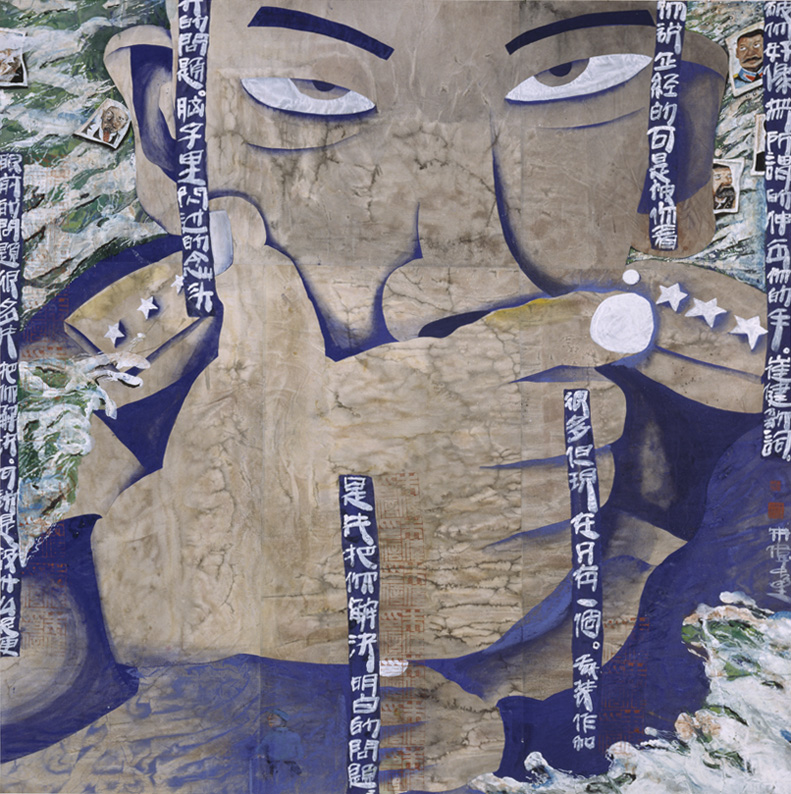|
| |
|

|
|
Relationship
Between Chinese Calligraphy and Painting
Origin
Shared by Calligraphy and Painting
Means
there’s a close relationship between Chinese calligraphy and painting,
the origin and development of the two supplement and complement each
other. <Record of Famous Paintings of Ancient Times · Narrate the
Origin of Painting> written by Zhan Yanyuan from the Tang Dynasty
says: “Cang Xie (a legendary figure whom believed to have created the
Chinese characters) has four eyes, sees every object in the universe.
According to the traces of birds and tortoises, he fixed the form of
scripts and characters. Because of the creation of characters, Nature
can’t hide its secrets anymore, so millet-rain drops from the sky;
gods and ghosts can’t hide their traces anymore, so ghosts cry at
night. Therefore, characters and paintings are consubstantial, both
originated from hieroglyph. Character is created to express meanings,
and painting is created to illustrate shapes.” This is the earliest
theory of “origin shared by calligraphy and painting”. Chinese
characters are pictograph, calligraphy and painting were originally
integrative and appeared in the same time; the tools they use are the
same, the techniques are shared and of reference to each other. Hence
calligraphy uses painting and painting uses writing, the two are closely
bound up in terms of proper planning of composition, structural use of
the brush, vivid spiritual consonance, and proper representation and
fidelity to object.
|
Inscription
The
scripts that are cast or engraved on ancient bronzes and sacrificial
vessels, Yan Shigu said: “the character kuan means engrave; and the
character zhi means inscribe.” The posterity also called the
signatures and writings on calligraphy and painting works
“Inscription”. “kuan” is seal, which includes name seal,
collection seal, and artistic seal; “zhi” is identification, refers
in particular to painter or writer’s name, style name, sobriquet, and
time of creation, etc.
|

|
| Inscript
and Postscript by Painter or to Recipient inscribed on a Painting
Usually
refer to writings on calligraphy, painting, or book, the contents
include superscription, comments and appraise, textual examination, and
adversaria, literary forms include prose, poetry, and ci poem. The
inscription on painting, Tang Dynasty painters only put tiny little
characters at tree root or rock crack, those not good at calligraphy
inscribed on the back of paper. In the Song Dynasty, it’s started to
put year and month on paintings, texts were only in slim regular script
and no more than two rows. Only Su Shi used big running regular script,
and wrote three to five rows of postscript. Yuan Dynasty painters
developed the contents of inscription from name and time to poem,
inscript and postscript, some exceeded 100 words. The vogue of inscript
and postscript prevailed in the Ming and Qing Dynasties, and had gone
down to nowadays. Wang Gai from the Qing Dynasty said in his <Mustard
Seed Garden Commentaries on Painting>: “seal was rarely used before
the Yuan Dynasty, inscription was hidden in rock cracks, because of the
worry that the calligraphy was not good enough and would damage the
composition of painting, till Ni Yunlin, whose calligraphy was powerful
and easy, who either put postscript after poem or poem after postscript;
Wen Hengshan’s inscription was clean and tidy; Shen Shitian’s
calligraphy was free and easy, Xu Wenchang’s poems were outstanding;
Chen Baiyang’s inscriptions were incisive and eminent; the
inscriptions often broke into paintings, added unusual charm to their
paintings.” From the Yuan Dynasty and on, inscribing writings, poems,
and inscriptions had become an artistic means to increase poetic charm
of Chinese Painting works.
|
| |
中国画的书画关系
书画同源 中国字是象形字,因此中国画和中国书法之间的关系非常密切,它们在起源和笔墨运用上都有相通之处。唐代张彦远在《历代名画记》卷一“叙画之源流”中第一次从理论上阐述了书画同源的问题:“颉有四目,仰观垂象。因俪鸟龟之迹,遂定书字之形,造化不能藏其秘,故天雨粟;灵怪不能遁其形,故鬼夜哭。是时也,书画同体而未分,象制肇始而犹略。无以传其意,故有书;无以见其形,故有画。” 张彦远借仓颉造字的传说来说明书画起源于同体的奥秘,直至发展到一定程度,书画才得以区分,书用于传意,画用于见形,但二者在气韵生动、骨法用笔、经营位置、传移模写上都有共通的要求。中国画对于笔墨的重视与书画同源说密不可分。
款识 《汉书·郊祀志下》 :“今此鼎细小,又有款识,不宜荐见于宗庙。”颜师古注:“款,刻也;识,记也。”后世将书、画上标题姓名,也称为款识。款即印鉴,识即作者名号、创作时间等。
题款 在画上题款是古人的习惯。画家本人也许会写上画作的标题、由来、记事等,或是题一首与画相关的诗词。如果是一幅著名画作,即使画的原作者不题款,后来收藏它的人时常也会在画上或画外增加的空白处写上对这幅画的品评或考据。清代皇帝乾隆就是一个酷爱在名画上题诗的人。画越出名,题款越多,如韩?的《照夜白图》,骏马照夜白的身前身后头上脚下,填满了后代人的题款。题款的位置也很讲究。中国画重气势,气势通的地方,即使空白也不能题款,以免造成阻塞,使画面变得板结。画上题款,唐代人只用小字藏在树根石罅间 ,书写不工的人多数只敢在纸的背面落笔。至宋代,才开始记年月,也仅用细楷,书不过两行。元人从款识姓名年月发展到诗文题跋,甚至有人在画上题上百余字。到了明清,题跋之风大盛,至今不衰。
印鉴 印鉴包括画家本人的名号章、收藏家的收藏章,以及别具趣味的闲章。与题款一样,著名的画作上往往也有为数不少的印鉴,如元代钱选的《浮玉山居图》,仅在原画范围之内的印鉴就有六十多枚,远望过去山峰平林上一片朱红的浮云。敢于在名作上留下收藏痕迹的人一般是名鉴赏家或名藏家,或爱好书画的皇帝。乾隆就是非常爱在藏画上钤印的人,如“乾隆御笔”、“石渠宝笈”、“乾隆御览之宝”、“乾隆鉴赏”、“三希堂精鉴玺”、“宜子孙”、“古希天子”、“犹曰孜孜”等都是这位清代皇帝的御玺。除上述的乾隆鉴藏印,近代较为著名的还有明代收藏家项元汴的鉴藏印“项元汴氏审定真迹”、“项子京家珍藏”、“子京父印”、“墨林”、“天籁阁”、“项墨林父秘笈之印”、“?李”、“项墨林鉴赏章”、“项叔子”,清代著名藏家梁清标的鉴藏印“河北棠村”、“苍岩子”、“蕉林居士”、“蕉林书屋”、“观其大略”、“苍岩子梁清标玉立氏印章”,清代藏家安岐的鉴藏印“安仪周家珍藏”、“朝鲜人”、“安岐之印”、“麓村”、“仪周珍藏”、“仪周鉴赏”、“安仪周书画之章”等。这些著名藏家的印鉴往往成为后人辨别古画真伪的重要依据。一般称一幅作品收尾时印上印鉴的过程为钤印。与题款类似,钤印的手法及落印位置都是极其讲究的。 |
|
|
|
|